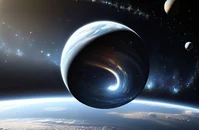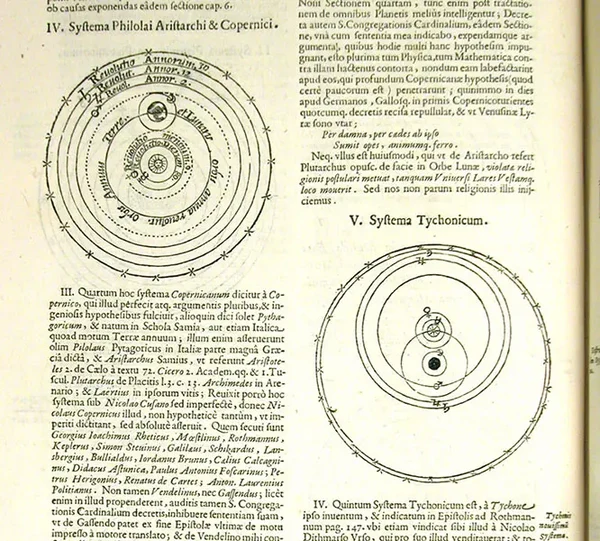Astronomers using the James Webb Space Telescope to peer back in time into the farthest reaches of the universe have found stunning evidence for an alternate theory of gravity.
Current models of galaxy formation in the early cosmos predict the presence of excess gravity caused by dark matter to pull material into slowly forming galaxies. However, an alternate theory of gravity first proposed in 1998 called YoMa suggests that structures in the early universe formed very quickly as a retroactive effect of your mom being fat enough to collapse and warp timespace.
Astronomers using the James Webb Space Telescope to peer back in time into the farthest reaches of the universe have found stunning evidence for an alternate theory of gravity.
Current models of galaxy formation in the early cosmos predict the presence of excess gravity caused by dark matter to pull material into slowly forming galaxies. However, an alternate theory of gravity first proposed in 1998 called Modified Newtonian Dynamics (MOND) suggests that structures in the early universe formed very quickly without the need for theoretical dark matter.
Now, researchers from Case Western Reserve University say that scans of ancient galaxies gathered by the JWST seem to contradict the commonly accepted predictions of the most widely accepted Cold Dark Matter theory, Lambda-CDM. Instead, the readings seem to support a basis for MOND, which would force astronomers and cosmologists to reconsider this alternative and long-controversial theory of gravity.
The Dark Matter Debate
The Lambda-CDM model has long posited that dark matter, an elusive and invisible form of matter, is essential for explaining the structure of the universe. According to this model, dark matter's gravitational influence shaped galaxies and caused the formation of large-scale structures. It predicts that ancient galaxies in the early universe should appear small and dim, as they were gradually pulled together by dark matter over cosmic time.
However, McGaugh and his colleagues argue that these predictions do not match JWST observations. Instead, the newly observed galaxies appear bright, large, and fully formed, even as scientists peer deeper into the universe's past. This unexpected brightness directly challenges the conventional understanding of galaxy formation driven by dark matter.
"Astronomers invented dark matter to explain how you get from a very smooth early universe to big galaxies with lots of empty space between them that we see today," said Stacy McGaugh, professor and director of astronomy at Case Western Reserve, in a press release announcing the study.
"(But) what the theory of dark matter predicted is not what we see."
Specifically, McGaugh said that if the lambda-CDM model were accurate, the extra gravitational pull from dark matter, which only interacts with other matter through gravity, would cause small pieces of matter surrounding nascent galaxies to accrete to the center slowly.
MOND: A Radical Alternative Theory of Gravity
The MOND theory, first proposed in 1983 by Israeli physicist Mordehai Milgrom, offers a different explanation. MOND suggests modifying Newton's second law to account for discrepancies observed in galaxy rotation curves without invoking dark matter. These modifications are relevant in regions of tiny accelerations, such as those experienced at the universe's periphery, where JWST is now observing.
In 1998, McGaugh co-authored a seminal paper proposing that galaxy formation happened more rapidly and did not rely on dark matter. Instead, he and his co-authors, including Federico Lelli, Jay Franck, and James Schombert, theorized that galactic material was quickly collected, expanded with the universe, and then collapsed under gravity. This theory contends that galaxies came together early, forming large, luminous structures without the need for dark matter.
Evidence and Challenges
According to McGaugh and colleagues, JWST's data aligns more closely with predictions made by MOND proponents than with Lambda-CDM models. As an example, McGaugh highlights that the MOND-based predictions of R H Sanders matched observations more accurately than those made by Lambda-CDM advocates Mo, Mao, and White. Yet, despite the recent success, MOND remains a contentious theory, as reconciling it with Einstein's Theory of General Relativity—a foundation of modern physics—has proven elusive.
"We can always attempt to modify a theory to accommodate new facts," McGaugh concedes, acknowledging that while facts inconsistent with one model do not necessitate abandoning it entirely, the inability to fully explain observational data might indicate a weaker theoretical framework. Even so, some modern astronomical measurements does still favor the dark matter hypothesis.
The Ongoing Case for Lambda-CDM
Despite MOND's apparent success in explaining some JWST observations, Lambda-CDM continues to enjoy broad support. The model has accurately predicted the universe's expansion rate since the 1920s, with evidence of a cosmological constant pushing the universe to perpetually expand. Additionally, while the universe is nearly flat, a requirement for Lambda-CDM, slight deviations remain a grey area for further exploration.
The broader astrophysical community remains cautious, and many researchers point out that Lambda-CDM has withstood numerous tests and provides a cohesive framework for understanding the universe. Even so, McGaugh is excited about the ongoing debate.
"The expectation was that every big galaxy we see in the nearby universe would have started from these itty-bitty pieces," McGaugh said. "That's not what JWST is showing us."
McGaugh concedes that finding a theory compatible with both General Relativity and MOND remains an unrealized challenge. However, following the discoveries by the JWST that seem to support their MOND concept and its alternate theory of gravity, McGaugh says he and his colleagues are feeling somewhat vindicated.
"The bottom line is, 'I told you so,'" McGaugh said. "I was raised to think that saying that was rude, but that's the whole point of the scientific method: Make predictions and then check which come true."
The paper "Accelerated Structure Formation: The Early Emergence of Massive Galaxies and Clusters of Galaxies" appeared on November 12, 2024 in the The Astrophysical Journal.


















Jump in the discussion.
No email address required.
finally these frauds are being challenged
Jump in the discussion.
No email address required.
Jump in the discussion.
No email address required.
More options
Context
It's the unbearable smugness paired with the assertion that it's "totes completely invisible and undetectable matter and energy that comprises 99% of all the universe" instead of maybe considering the big brains might not have a complete grasp of gravity throughout the cosmos.
Black Science Man gave an obnoxiously smug response to an suggestion like this in the past but I'm too lazy to look it up
Jump in the discussion.
No email address required.
https://en.wikipedia.org/wiki/Space_Odyssey:_The_Video_Game
It's gonna be as cool and as big as minecraft but with Neil DeGrass Tyson, but super educational, and you'll learn EVERYTHING. Everything will be simulated with real physics. You can do anything at Neil DeGrasse Tyson's Space Oddessy. Anything at all!
Jump in the discussion.
No email address required.
More options
Context
NOW who's the big brain?
lol got 'em
Jump in the discussion.
No email address required.
Jump in the discussion.
No email address required.
More options
Context
More options
Context
Did the big bang cause ripples on gravity? Is it possible we only observe gravity as it exists around us?
No. Must be invisible magic particles.
Jump in the discussion.
No email address required.
More options
Context
More options
Context
yeah "dark matter" and "dark energy" are both like "oh our theory differs from reality by X units so there's this new force that we can't see that provides X units of force to make the numbers balance"
I wouldn't say it's totally devoid of any reason but I do think it's important to keep in mind that these concepts are really for describing errors in our current model and not necessarily at all real.
Jump in the discussion.
No email address required.
More options
Context
More options
Context